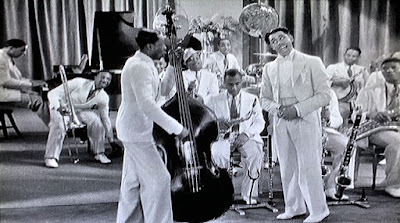International House 1933 Paramount (69 minutes) directed by Edward Sutherland, screenplay by Francis Martin and Walter DeLeon; cinematography by Ernest Haller; costumes by Travis Banton.
This zany W.C. Fields vehicle is an odd little pre-code gem of a variety show, set in China, which even more oddly would prefigure the brave new world of YouTube TV.
A lot happens in the film’s running time of slightly more than one hour.
Dr. Wong (Edmund Breese), a Chinese inventor, intends to sell the rights to his video-receiving ‘radioscope’ at International House, a luxurious hotel in Wu Hu, China.
The radioscope is an eccentric and marvelous wi-fi-like contrivance a generation before most Americans even could imagine television. Here it provides a venue for the full range of popular radio, news, sports, and musical and comedy acts of the day. In one scene, Fields ‘interacts’ with several video clips—much less surrealistically in our YouTube day than it was in his own.
(John Seabrook wrote recently of YouTube’s new television venture in Streaming Dreams in The New Yorker magazine, January 16, 2012.)
The American Electric Company sends Thomas Nash (Stuart Erwin), a boyish, earnest American executive, to Wu Hu to buy the rights. Since these movies invariably include a love story, Nash hopes to marry Carol Fortescue (Sari Maritza), daughter of Sir Mortimer Fortescue (Lumsden Hare), a senior British commercial representative.
Peggy Hopkins Joyce, whose contemporary celebrity apparently derived from serially beneficial marriages, plays a recherchée platinum blonde fashion plate trying to snag a rich new husband whilst teasing her rich ex, General Nicholas Baranosky Petronovich (Bela Lugosi) who is also in town to buy the rights to the radioscope.
And Professor Henry R. Quail (Fields) is circumnavigating the globe in his autogyro ‘The Spirit of Brooklyn’ (Charles Lindberg made his famous New York-Paris flight in ‘The Spirit of St. Louis’ six years before the movie came out), headed for Kansas City but landing instead on the roof of Wu Hu’s International House.
The opening title is Chinese. The Chinese signage looks legitimate; there are many uncredited Chinese extras and, occasionally, the Chinese characters (and once Nash) speak Chinese. That said, a Caucasian actor plays the lead Chinese character, Dr. Wong. And the fictional place name ‘Wu Hu’ is a running joke throughout the film, from train whistles to cuckoo clocks to a small Chinese newsboy.
When Fields first lands his autogyro on the hotel, he asks whether he is in Kansas City, Kansas, or Kansas City, Missouri.
‘Whoo-hoo!’ calls out Joyce.
‘Whoo-hoo to you, sweetheart,’ Fields says, then gesturing to the hotel manager (Frederic Pangborn), ‘Hey Charlie, where am I?’
‘Wu Hu,’ replies the feyly peevish Pangborn.
Fields pulls the carnation from his buttonhole.
‘Don’t let the posy fool you.’
Everyone settles down for the floor show—a ‘Cosmopolitan Chorus of 50 International Beauties and Sing How’s Syncopators’—with Lona André as a ‘China Tea Cup’ and Sterling Holloway as the American sailor ‘Coffee Mug’, an array of lovely women in not much besides clear plastic tea service costumes, see-through silks, and matching lyrics—‘She was a saucy saucer, who met him at every meal/She was a torso tosser, with lots of sex appeal.’
The finale is along these lines of, but surprisingly more revealing than The Dude’s dream flight beneath bowling pins’ skirts in The Big Lebowski (1998). Leave it to beaver shots: no wonder some of the men with floorside tables watch through opera glasses.
Fields’ scenes are loaded with his quickly discarded double entendres, the funnier because he shuffles from one to the next better with little fanfare.
Joyce: ‘I’m sitting on something.’
Fields: ‘I lost mine in the stock market.’
(It turns out of course that she is sitting on a ‘pussy,’ which Fields releases to live its other eight lives.)
Woman: ‘Won’t you join me in a glass of wine?’
Fields: ‘You get in first, and if there’s room enough, I’ll join you.’
 |
| Peggy Hopkins Joyce: 'Now can you see anything?' Fields: 'Practically everything.' |
There is a lovely, silent three-minute sequence in which first Fields, then Joyce, enter the same hotel room, undress, prepare for and get into two very close twin beds without seeing each other until he starts snoring after they turn the lights out.
Perhaps the most surprising content comes in Cab Calloway and his band’s appearance on the radioscope. The bass player is beating rhythmically at his strings.
Calloway: ‘What’s the matter with this cat here?’
Band: ‘He’s high!’
Calloway: ‘What do you mean, he’s high?’
Band: ‘Full of weed.’
Calloway: ‘Full of weed?’
Band: ‘Yeah!’
Calloway: ‘Who is this cat anyway?’
Band: ‘That’s the reefer man.’
Alas, the fun ended in 1934, when the Hayes Office started to enforce the industry’s self-imposed ‘Production Code’—censorship guidelines on sexual and moral content—and continued to do so for nearly three decades.





No comments:
Post a Comment